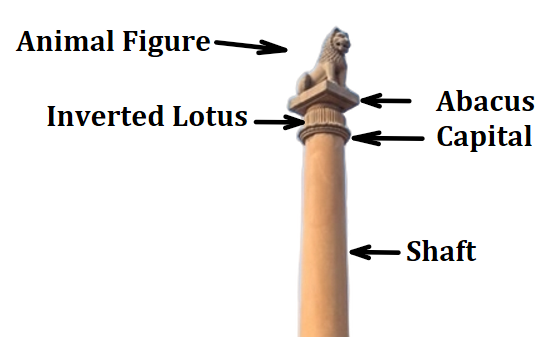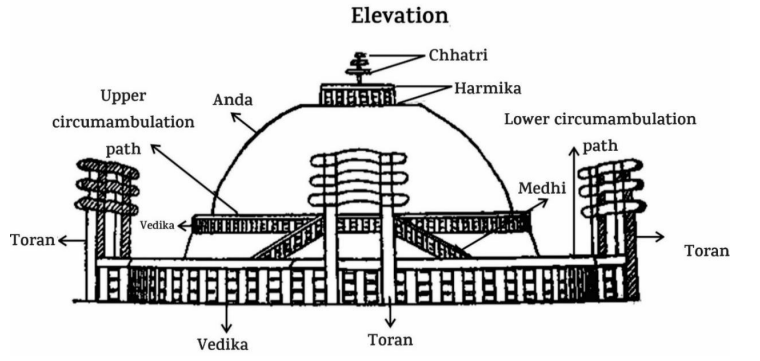Day 2: Discuss the features of Mauryan art and architecture and its relationship with Buddhism. (38 Marks)
04 Mar 2025 | GS Paper 1 | HistoryApproach / Explaination / Answer
Approach
|
Introduction
Mauryan art (322–185 BCE) was a crucial phase in Indian history, marked by grand structures, intricate carvings, and a transition from wood to stone. It played a key role in Indian architectural evolution and the spread of Buddhism, particularly under Emperor Ashoka, who patronized polished sandstone pillars, stupas, rock-cut caves, and sculptures.
Body
Mauryan Palaces:
- Location & Purpose: Chandragupta Maurya built his palace in Pataliputra to reflect Mauryan grandeur. The remains, especially the assembly hall, showcase its vastness.
- Construction:
- Primarily wooden, later expanded by Ashoka using stone.
- Surrounded by wooden walls with arrow slits (as noted by Megasthenes).
- Architectural Features:
- The assembly hall measured 140x120 feet.
- The Eighty-Pillared Hall at Kumhrar had a wooden roof and monolithic stone pillars.
- Inspired by Persian Achaemenid styles, combined with indigenous techniques.
Mauryan Pillars:
- Purpose & Significance: Built during Ashoka’s reign to promote Dhamma and mark key Buddhist sites.
- Key Features:
- Made of polished Chunar sandstone with a mirror-like finish.
- Decorated with lifelike animal figures symbolizing Buddhist principles.
- Structural Components:
- Shaft: Single stone, slightly tapering.
- Capital: Inverted lotus/bell shape.
- Abacus: Platform with intricate animal carvings.
- Animal Figure: Lions, bulls, elephants, or horses with symbolic meaning.
- Types:
- Scripted Pillars: Inscribed with Ashoka’s edicts (e.g., Sarnath, Sanchi, Rampurva).
- Plain Pillars: Non-inscribed, artistic markers (e.g., Basadh, Kosra).
- Notable Pillars:
- Sarnath Pillar: Features four lions, now India's national emblem.
- Rampurva Pillar: Depicts a bull in Lalit Mudra.
- Lauriya Nandangarh Pillar: Contains Ashokan inscriptions on Dhamma.
Mauryan Stupas:
- Definition & Purpose: Stupas are Buddhist burial mounds preserving relics and promoting Buddha’s teachings.
- Key Features:
- Torana: Decorated gateways with Jataka tales.
- Vedika: Protective stone railing.
- Pradakshina Path: Circumambulatory pathway.
- Anda: Hemispherical dome symbolizing the universe.
- Harmika: Box-like structure symbolizing heaven.
- Chhatri: Three-tiered umbrella symbolizing Buddha, Dharma, and Sangha.
- Famous Stupas:
- Sanchi Stupa (MP): UNESCO site, initially built by Ashoka, expanded by Sungas.
- Bharhut Stupa (MP): Early stone gateways with Buddhist inscriptions.
- Dhamekh Stupa (Sarnath, Uttar Pradesh): Marks Buddha’s first sermon.
Mauryan Caves:
- Function: Served as viharas for Buddhist and Ajivika monks, India’s earliest rock-cut structures.
- Main Locations: Barabar Hills and Nagarjuni Hills (Bihar).
- Notable Caves:
- Barabar Hills: Lomas Rishi, Sudama, Viswamitra, Karna Chopar.
- They have inscriptions by Ashoka
- Nagarjuni Hills: Vahiyaka, Gopika, Vadathika.
- They have inscriptions by Dasaratha.
- Barabar Hills: Lomas Rishi, Sudama, Viswamitra, Karna Chopar.
- Distinct Features:
- Highly polished walls mimicking wooden structures.
Mauryan Folk Art:
- Pottery:
- Used for functional and decorative purposes.
- Northern Black Polished Ware (NBPW): Shiny black finish, common in Pataliputra.
- Painted Grey Ware: Black-and-red designs.
- Sculpture:
- Made of brown sandstone, with polished, lifelike detailing.
- Religious Influence:
- Yaksha-Yakshini Statues: Guardian deities.
- Jain Tirthankars: Found in Patna.
Relationship of Mauryan Art with Buddhism:
- Ashokan Pillars: Located at key Buddhist sites like Lumbini and Sarnath, spreading messages of morality, non-violence, and compassion.
- Stupas: Built on a large scale, housing Buddha’s relics and serving as centers of devotion.
- Rock-Cut Caves: Provided monastic shelters for Buddhist and Ajivika monks, with highly polished interiors.
- Artistic Depictions:
- Jataka tales carved on stupas and caves, making Buddhist teachings accessible to the masses.
Conclusion
Mauryan art and architecture marked a golden era in India’s cultural history. Its structures, sculptures, and urban planning set foundations for future architectural advancements. Its legacy continues to inspire and educate on India’s socio-political and religious past.


